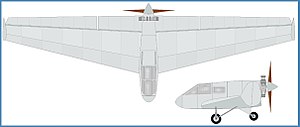Kharkiv KhAI-4
| Kharkiv KhAI-4 | |
|---|---|

| |
| Role | Experimental tailless aircraft |
| National origin | USSR |
| Manufacturer | Kharkovskii Aviatsionni Institut |
| Designer | P.G. Benning, A.A. Lazarev, A.A. Krol |
| First flight | October 1934 |
| Number built | 1 |
The Kharkiv KhAI-4 was an experimental Soviet tailless aircraft tested in 1934. It only made three flights before being grounded as dangerous.
Design and development[edit]
The KhAI-4 was the Kharkov Institute's first tailless design, making its first flight two years before the Kharkov KhAI-3. It was an all-wood machine.[1]
It was rather similar in layout to the powered version of the Lippisch Delta 1, first flown three years earlier in 1931, and had similar dimensions but a much more powerful engine.[2][3] Its low-mounted wing was tetragonal in plan, with sweep (15°) only on the leading edges. Wing tip fins, which had a blunted triangular profile, carried slightly more rounded rudders. Ailerons occupied the outer 65% of each wing, with the rest filled with an elevon. The controls were essentially conventional, with rudder pedals and a wheel for the ailerons which, when pushed or pulled moved the elevons together to change pitch.[1]
Its fuselage was short but deep, with an enclosed cabin over the leading edge holding two seats in tandem. A Shvetsov M-11 radial engine, working in pusher configuration, was mounted high on the rear fuselage with its five cylinders exposed for cooling. Under the engine the fuselage was cut away.[1]
The KhAI-4 had a conventional fixed undercarriage, though the need for propeller ground clearance required a long tailwheel leg, producing a low ground angle of attack.[1]
Operational history[edit]
The first flight was piloted by B.N. Kudrin, who found insufficient elevon authority to lift the nose for take-off until he reached 180 km/h (110 mph; 97 kn), the design maximum airspeed. Pitch instability dominated the rest of the flight, though he landed successfully. Two more flights were made before the KhAI-4 was grounded as dangerous.[1]
Specifications[edit]
Data from Russian Aircraft 1875-1995[1]
General characteristics
- Crew: two
- Length: 4.2 m (13 ft 9 in)
- Wingspan: 12.0 m (39 ft 4 in)
- Wing area: 21.25 m2 (228.7 sq ft)
- Empty weight: 550 kg (1,213 lb)
- Gross weight: 850 kg (1,874 lb)
- Powerplant: 1 × Shvetsov M-11 5-cylinder air-cooled radial, 93 kW (125 hp) . Sub-type not known so power uncertain.
- Propellers: 2-bladed
Performance
- Maximum speed: 180 km/h (110 mph, 97 kn) at sea level
- Range: 600 km (370 mi, 320 nmi) design target
- Service ceiling: 3,250 m (10,660 ft) estimated service ceiling
- Landing speed: 100 km/h (62 mph; 54 kn)
References[edit]
- ^ a b c d e f Gunston, Bill (1995). The Osprey Encyclopedia of Russian Aircraft 1875-1995. London: Osprey (Reed Consumer Books Ltd). p. 148-9. ISBN 1-85532-405-9.
- ^ Bowers, Peter M. (1984). Unconventional Aircraft. Blue Ridge Summit: Tab Books Inc. p. 40-1. ISBN 0-8306-2384-1.
- ^ "L'avion sans queue Lippisch, de la R.R.G." L'Aérophile. 39 (X): 299. 1–15 October 1931.
